Organizations often find themselves at a loss of where to begin when it comes to their content creation strategy. By effectively leveraging keyword research and competitor analysis, you’ll start to gain a better understanding of what your audience is searching for, what is working for your competitors, and how you can provide greater value when compared to your competitors.
This post will break down:
- Tools that you can use to perform this analysis
- Steps on how to get started on your research
- How to start putting your content strategy to work
If you’re looking for a one-time project, then this task isn’t for you; This tactic, like many other tactics in business requires continuous monitoring and enhancements based on what your data is telling you.
We’re now in a digital era, so let’s get started.
Tools That Will Perform Keyword Research and Competitor Analysis
“A good tool improves the way you work. A great tool improves the way you think.” – Jeff Duntemann
Whenever asked which tools work the best, there are three main players that come to mind first.
Each have their own value-adds, but this article does a great job of breaking down each product and what they bring to the table.
Throughout this article, the interface that you’ll see is from SEMrush; However, regardless of the tool that you choose, they’ll each help you get the job done and ultimately change the way that you think and make decisions for content creation.
Performing Keyword Research
- Build a List
Best practice is to start building out a list of keywords within an excel sheet that you’d like to target. If you’re reading this then you’re most likely in the earlier stages of your keyword research and competitor analysis journey, so focus on keyword phrases rather than just broad terms. Here’s a chart giving examples that further explain the difference.
| Keyword | Keyword Phrase |
| Ice cream | Strawberry ice cream |
| Coffee shop | Best rated drip coffee shop |
| Consultant | Digital marketing consultant |
The difference between a keyword that contains 1-2 words and a keyword phrase that contains 3-5 words is that the keyword phrases are much more specific. By honing down on exactly what you offer or what your value-add is, you’re more likely to drive quality traffic to your website by getting in front of the audience that is actually searching for what you’re offering.
- Determine the traffic volume and keyword difficulty of your target phrases
Now that you have a list compiled of keyword phrases that you’d like to target, it’s time to put them into your determined SEO tool and analyze how frequently the term is searched for, as well as how difficult it will be to rank for that term.
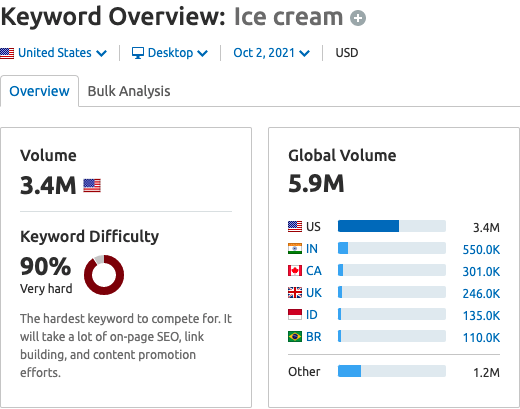
You’ll notice that the keyword ‘ice cream’ has significant search volume but is very difficult to rank for. This is why searching for a phrase often makes more sense.
Here’s an example for ‘strawberry ice cream’.
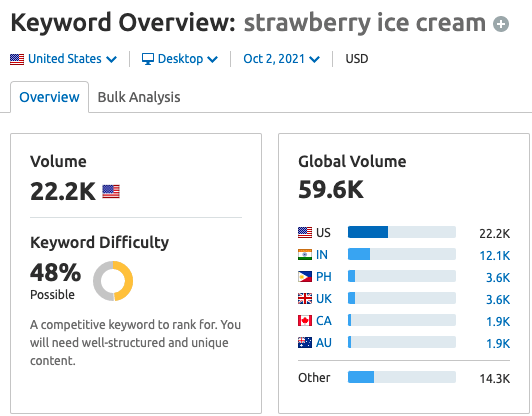
The results are broken down into 2 parts:
- Search volume
- Keyword difficulty
You’ll notice that by using a phrase/term that’s more specific (strawberry) to the term we’re searching (ice cream) greatly lowers the search volume but becomes much more attainable to rank for (keyword difficulty).
The tools also enable you generate ideas by showing data for:
- Keyword variations
- Questions
- Related keywords
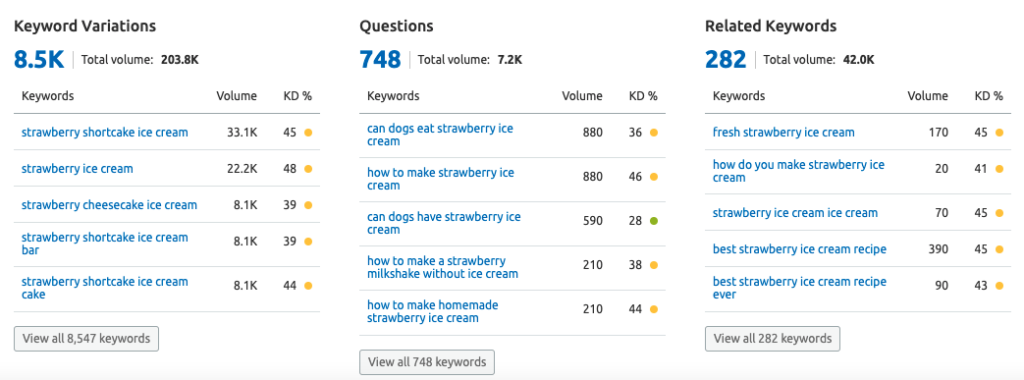
You now have search volumes for all three of these sections and can better determine exactly how much more value you can provide for your audience based on what they’re searching for.
Hint: be sure to populate this data in your keyword list.
Finding keyphrases with desired search volumes is only half the battle; The remaining portion entails viewing how difficult it will be to rank for that keyword.
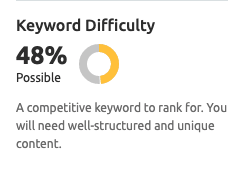
KD % stands for keyword difficulty, and anything over 60 becomes incredibly difficult to rank for given intense competition. Sticking with ‘strawberry ice cream’, we see that it has a high monthly search volume (22.2K) and relatively fair when it comes to difficulty of ranking for the phrase (48%).
In many cases, the keyword variations just won’t make sense for you to target due to either low search volume, high KD%, or a combination of the two. In that case, the questions and related keywords sections enable alternative ideas for your organization to target that still enable you to communicate your overall message and value-add to your audience.
- Begin executing on your content strategy for your determined keyphrases
Now that the SEO tool has enabled you to determine what keyphrases make the most sense, you can put the research and reporting to work by executing on your content strategy. Some of the more popular forms of content creation that you might consider include but aren’t limited to:
- Blogging
- Podcasting
- Landing page development
- Video
- Infographics
The most impactful strategy will leverage a combination of the above so that your audience can consume your content in a means that best suits their desired consumption method. One user may enjoy reading text while another may prefer to watch a video.
By leveraging the targeted keyphrases, related keywords, and questions that users are searching for, you’re able to better understand some of the exact questions/topics that your users are interested in, and offer content that helps inform.
The better you inform your audience within your content strategy the more likely you are to receive ‘intent to purchase’ traffic.
Perform Competitor Analysis to Further Develop Your Strategy
The first portion of this discussion primarily focused on brainstorming your own keywords, testing the validity of them within the auditing tool, and leveraging new ideas to better implement a content creation strategy.
The next portion of this discussion will focus on how you can use competitor analysis to further improve your strategy.
- Identify your top 3 competitors
Your competitors don’t have to be in the same revenue bracket, or even the same geographic location for that matter. Your top competitors should present an image that is currently superior to your brand, but ultimately offer the same value to customers.
It would be much easier to compare your organization to a company that is similar in size, but a bigger brand gives you a higher target to strive toward.
- Input competitors into analysis tool
Once identified, enter the domain of your competitor into the analytics tool.
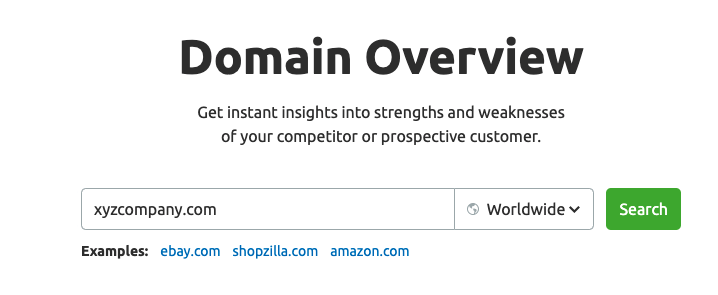
Once inputted, you can begin analyzing traffic, organic keywords, further competition, and level of difficulty to compete with them.
- Analyze the competitor data
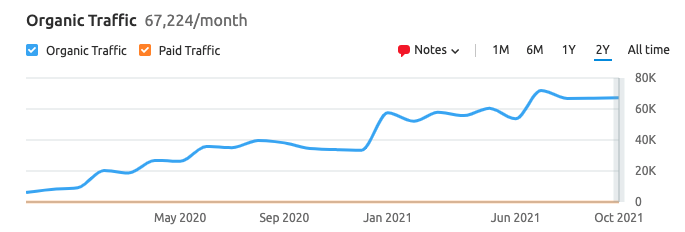
To further dive into their traffic, here are some insights from their top organic keywords that they rank for.
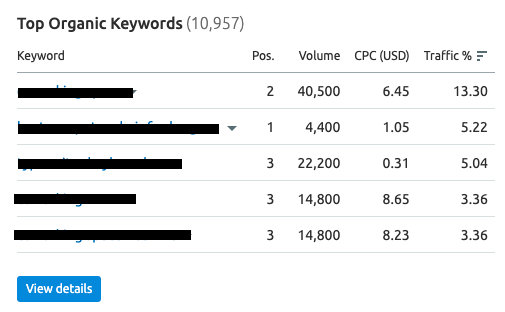
In addition to their top ranking keywords, the analysis will also provide additional competitors and where they rank on a competitive positioning map.
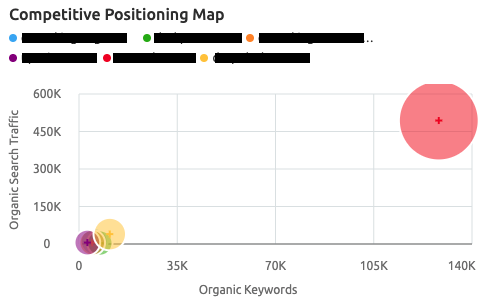
These charts make competitors that you may not have known even existed more visible to your business, and also outlines the level of difficulty your business can expect while trying to outrank them/compete for organic traffic.
- Create execution strategy based on the competitor analysis
After competitor analysis is completed you’ll gain a much better understanding of:
- Keywords that you should be targeting
Competitors that drive more traffic than you give you a better idea of the keywords that you should go after, and your organization can then ensure that quality content is created to gain some of that traffic share.
- Further competition based on the inputted URL
In addition to the keywords that your identified competitors are targeting, you’re exposed to further competition that you may or may not have known about previously. This gives your business more keywords and content to analyze, and determine which make the most sense.
- Level of difficulty to outrank your competitors
Regardless of the level of difficulty when trying to outrank a competitor, you’re able to get creative by using keyphrases, rather than just keywords to drive traffic to your website. This levels the playing field between a small startup and a large enterprise organization. That’s not to say it will be easy, but you’ll still be able to develop strategies based on your analysis that allow you to compete.
- Traffic trends over time
The first chart that was shown of a competitor showed a sharp decrease in traffic over the second half of the year. It’s important to analyze this across multiple competitors and determine what may have caused that decline. Knowing whether it’s specific to one company or whether the industry is collectively seeing a decline in traffic can help you dive further into cause and analysis.
Final Thoughts
Keyword research and competitor analysis should complement one another to best drive your content marketing strategy.
By leveraging the right tools you’ll have access to data on your own organization, your competition, and overall industry as a whole. As we continue to enter an era where data drives decision making, it’s important to ensure you have access to the data and are able to analyze it for strategizing.
Whether you’re a marketer, professional athlete, or small business owner, the data will drive your decisions and it starts with research and competitor analysis.
Reach out and let us know if you’re looking to implement these tools for your organization.

Gary McConnell Co-founded Rubicom Digital in 2019 with a goal of providing digital marketing consulting services in the B2B space.
Gary continues to serve as the Marketing Director of a Data Center-focused IT Provider, VirtuIT Systems.

